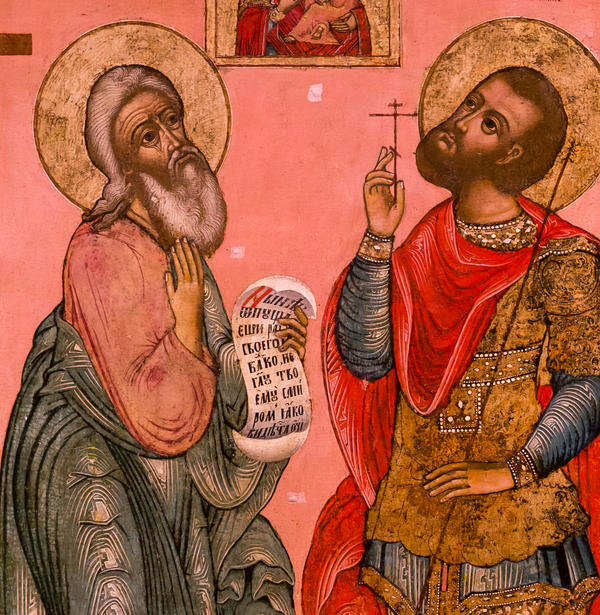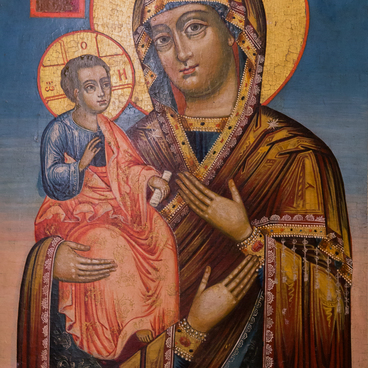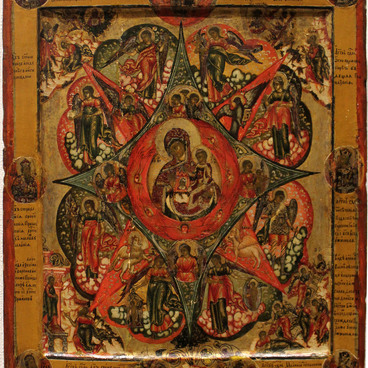This icon was written by an unknown master in traditions of the Kremlin Armory school in the second quarter of the 18th century. This school arose up in the 1640s in the Kremlin. Its leading master Simeon Ushakov sought to bring features of realistic art to icon painting. He used to say that depicting God and Saints should be in the same manner as of ordinary people. In Russia he was the first who began painting the righteous, using light and shadows. Such method helped to give volume to ascetic bodies and emphasized the individual features of the faces.
Icon, Simeon the Righteous and John the Warrior
Время создания
second quarter of the XVIII century
Размер
107x58 cm
107х58 сm
107х58 сm
Техника
wood, gesso, tempera
Коллекция
5
Открыть в приложении#1
Unknown artist
Icon, Simeon the Righteous and John the Warrior
#2
#5
Depicted in the left scene of the icon is Simeon the Righteous, and on the right scene - Martyr John the Warrior. They turned towards the Tikhvin image of the Mother of God in a prayerful attendance. Elder Simeon the God Receiver was a prophet: he divined to Virgin Mary the fate of her son.
#3
In his left hand he holds a scroll with a text from the Gospel of Luke: ‘Lord, now let your servant depart in peace, according to you word; for my eyes have seen your salvation….’
#4
These were the words of St. Simeon when he took Jesus Child into his arms at the time when Mary and Joseph brought Jesus into the Temple of Jerusalem. John the Warrior helped the righteous to escape from the dungeon at the time of persecution of Christians in the fourth century. The cross in his hands symbolizes devotion to Christian ideals.
The Tikhvin Mother of God icon depicted in the center of the image, was located at Tikhvin Assumption Monastery. This icon was recognized as patron saint of St. Petersburg and of northern boundaries of the state. As the legend says, in 1383 this icon miraculously appeared in the air near river Tikhvinka in the principality of Novgorod. It travelled many places before it had found her final residence.
The Tikhvin Mother of God icon depicted in the center of the image, was located at Tikhvin Assumption Monastery. This icon was recognized as patron saint of St. Petersburg and of northern boundaries of the state. As the legend says, in 1383 this icon miraculously appeared in the air near river Tikhvinka in the principality of Novgorod. It travelled many places before it had found her final residence.
#7
In 1515 by the order of Grand Duke Basil III the Assumption Cathedral was built specially to host the icon. In 1526 the Prince visited the Tikhvin Shrine to pray for the birth of a child. Soon he had a son - the future king Ivan the Terrible. Shortly after this event the icon become wonderworking. In 1546 Tikhvin Assumption Monastery was built at the cathedral. In the early 17th century a battle with the Swedish troops took place near the walls of the monastery. The God Mother was prayed for her intercession in the battle, and the Russian troops had won. During the Great Patriotic War the icon was moved to Europe and then to America. For a long time the icon was in Chicago. In June 2004 the ancient shrine returned to the Tikhvin Monastery.
The artist performed the icon Simeon the Righteous and Warrior John the Martyr in an unusual color scale. He imprinted the Saints against a pink background and painted the fields with a light ochre. Master painted chiton of Simeon the Elder in ochre and greenish hues, and traced folds with white colors. He portrayed John the Warrior in a contrasting bright red cloak- thus the painter made an additional color accent. The golden haloes of the Saints echoed the golden background of the icon of Our Lady of Tikhvin that is at the top of the composition.
#8
According to one of the versions, the icon of Simeon the Righteous and John the Warrior was written in the workshop of Tikhvin Monastery, where icon of Virgin Mary of Tikhvin was hosted. Copies of this icon for temples all over Russia were written in the monastery.
#9
New Jerusalem Museum
читать дальшескрыть
00:00
00:00
1x
Icon, Simeon the Righteous and John the Warrior
Время создания
second quarter of the XVIII century
Размер
107x58 cm
107х58 сm
107х58 сm
Техника
wood, gesso, tempera
Коллекция
5
Открыть в приложении
Поделиться



